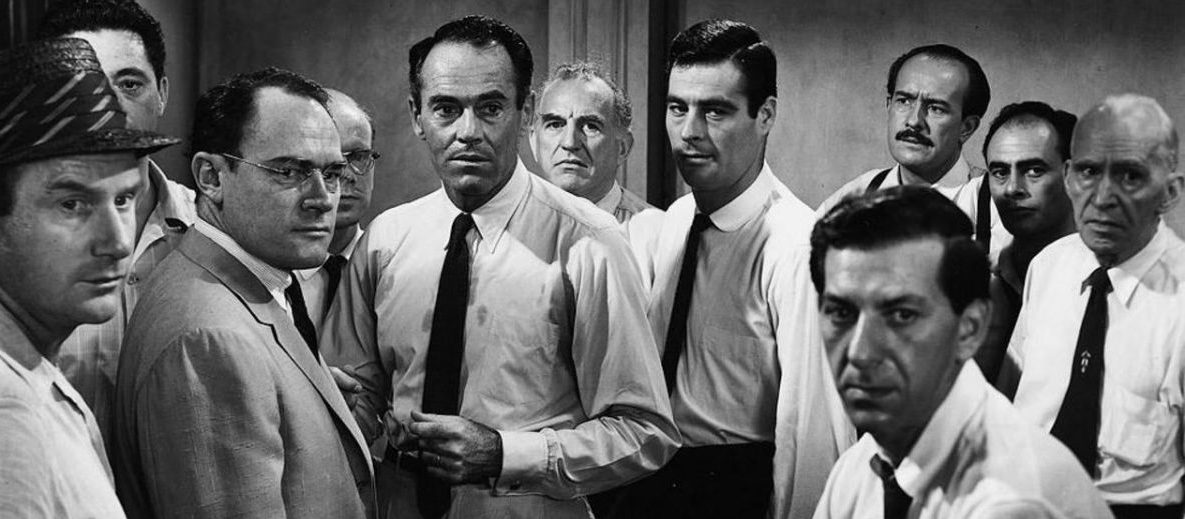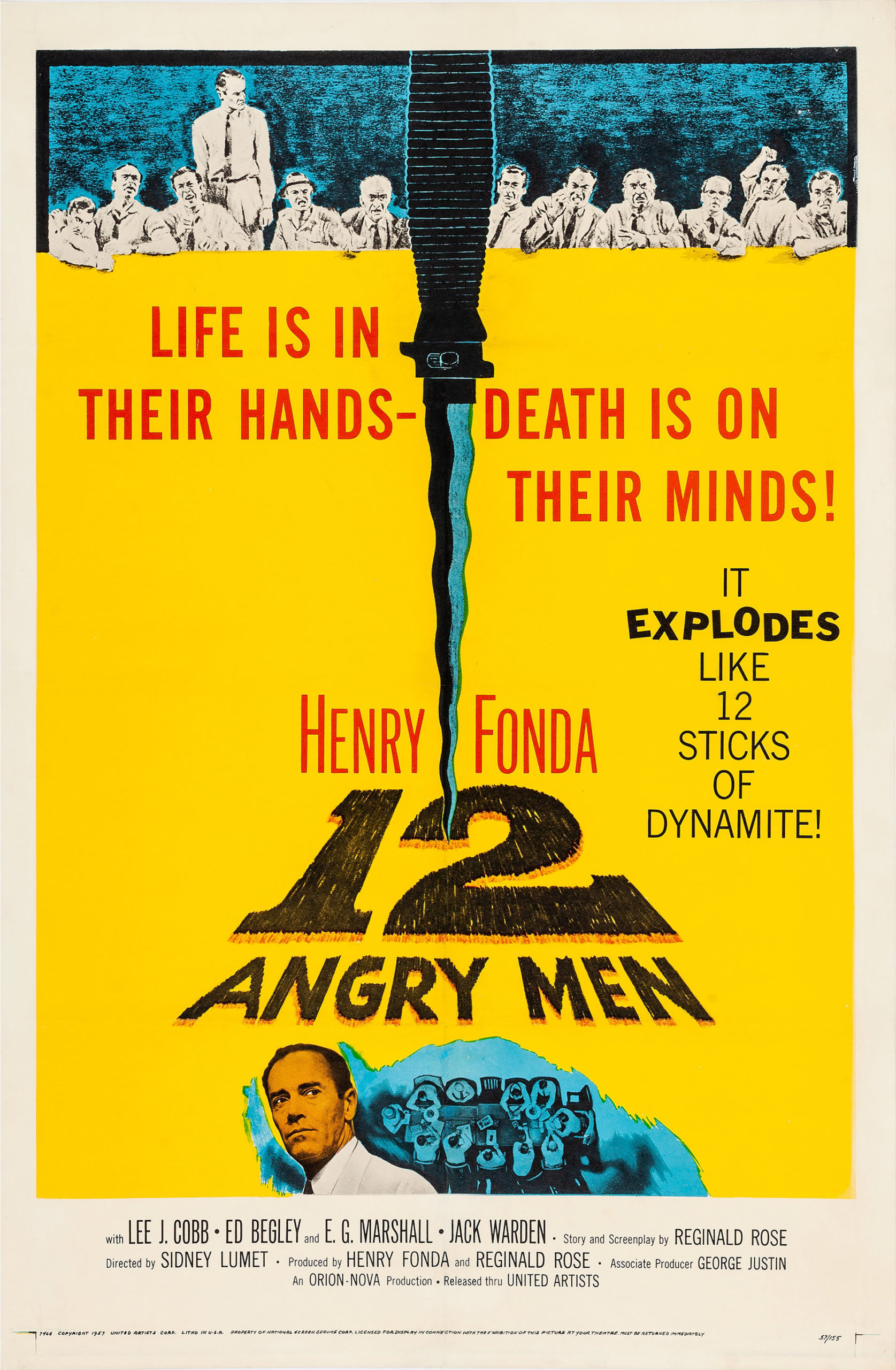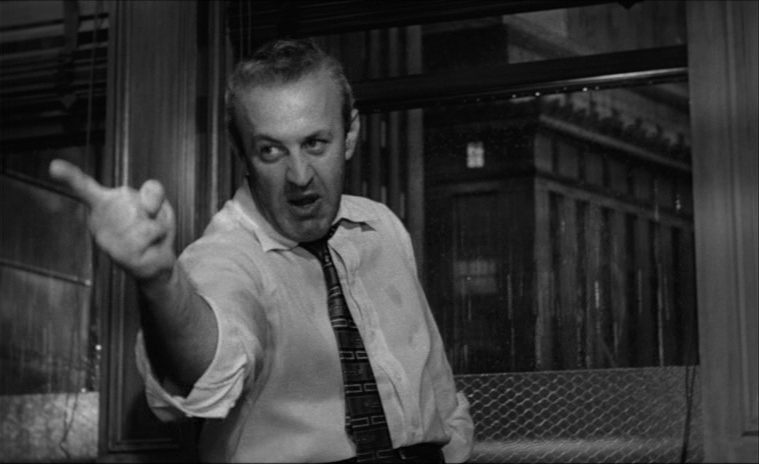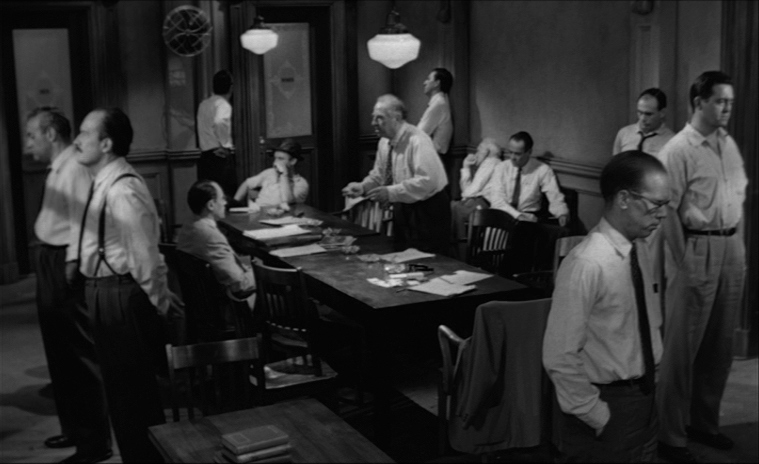

“You’ve listened to the testimony, you’ve had the law read to you and interpreted as it applies in this case, it’s now your duty to sit down and try to separate the facts from the fancy.”
12 Angry Men has seen numerous adaptations. It began life as a teleplay, was soon adapted to the silver screen, then made into a television special a few decades later, then it found its way to Broadway. The most exceptional version is Sidney Lumet’s debut feature, which perhaps stands as his best film (although it’s a hard decision when Dog Day Afternoon is in the mix). Although Lumet left his mark on the material, as did William Friedkin in the late 1990s, 12 Angry Men is primarily about the acting and dialogue. Sure, there’s a murder mystery at its center that leads us into social commentary and critiques of the American legal system, but everything hinges on those two things and that’s where the attention belongs. Reginald Rose, who wrote the original teleplay, adapted his own work for Lumet’s film version and the cast is uniformly excellent in bringing his work to life.
Playing out in real time in a single room, the film takes us behind the doors of a jury deliberation room where twelve jurors from different walks of life are tasked with assessing the facts of a murder case. Off the bat, all but one of the men are ready to vote “guilty”—one juror short of the unanimous decision required to end the proceedings and send a young man to the electric chair. The young man is shown to us only a single time, as he watches the jurors shuffle out of the courtroom with sad eyes, immediately creating an unconscious swell of sympathy. The holdout, Juror #8 (Henry Fonda), believes there is reasonable doubt about the case and tries to lay out the rationale behind his uncertainty. As one question leads to another, the jurors regularly call for re-votes, and each time additional jurors have shifted their vote to “not guilty.” It’s not all cut and dry analysis of facts. In fact, many of the swaying arguments on both sides are made from out of bounds and several jurors are driven by unrelated personal issues. Some are simply anxious to get out of the jury room because it’s overbearingly hot and the fan doesn’t work. Even Juror #8, whose defiance against the others initially paints him as a white knight, uses some questionable tactics to convince the others. He goes so far as to provoke Juror #3 to anger, at which point he threatens to kill Juror #8, simply to prove that sometimes angry people threaten crimes they don’t intend to commit.

There are two narrative threads that occur simultaneously in the film. The first is the obvious whodunit, with the jurors arguing about testimonies and various forms of evidence. The aim of this narrative is to color a blurry picture for the audience such that we become uncertain about what transpired. Starting with rock solid, air tight testimonies, one small question leads to another until we’re uncertain who did what. Because a concrete resolution is not needed—the jurors only need to conclude that they have “reasonable doubt”—we don’t need as many contrivances as a typical murder mystery, and the inevitable conclusion of a unanimous “not guilty” vote does not feel cheap. As the viewer is not privy to the courtroom proceedings, we only learn the facts as they’re presented in the deliberation room. In this way the script ingeniously positions us to side with the eleven “guilty” voters until we’re swayed along with them to change our vote.
But below that surface level story, 12 Angry Men is not about its central crime. Rather, it is interested in exploring the inner workings of a jury room—how the individual personalities and upbringings of the jurors can affect the eternal fate of the accused. Aided by the real time story and single location, Lumet chose to shoot the film sequentially. This provides a significant boost to the texture of the film, as all twelve jurors gradually reveal their personalities and conflicts develop between them in a very organic manner. Juror #8 is the calm voice of reason, confessing that he is not certain of the boy’s innocence, but that he is not ready to assign guilt. He believes when a man’s life hangs in the balance, thoughtful dialogue on the part of the jury is only fair. A few others take their job seriously—Juror #1 (Martin Balsam), the jury foreman, is methodical in his duty; Juror #4 (E.G. Marshall) is precise and logical. But others are concerned with things that do not pertain to the case at all. Juror #10 (Ed Begley) has seen the young boy, and his bigotry mars his perception of the case. Juror #7 (Jack Warden) is willing to vote with the crowd—hopeful that things can be quickly wrapped up so he can make it to the baseball game. Juror #3 (Lee J. Cobb) is too affected by his own struggles raising a son to believe the boy might be innocent, seeing the defendant not as an individual human life but as a symbol of his own failure. The only stance that rings hollow is Juror #10’s overt bigotry. A sign of the times, perhaps, as his obnoxious tirades and expectation of assent from his fellow jurors feel overblown and inauthentic from a 21st century perspective. Nonetheless this leads to some wonderfully tense moments, such as when Juror #5 (Jack Klugman) reveals that he grew up in the slums just like the young boy, referred to as “one of them” by Juror #10; or when he is shunned by the other jurors when his bigotry becomes too much for them to bear.

Aside from the indictment of the era that bubbles up in Juror #10, 12 Angry Men has aged remarkably well. It’s a lean, careful film that is concerned with issues that are just as relevant today as they were more than half a century ago—court-assigned lawyers not interested in defending their clients, stereotype prejudices amongst the jurors, the solemnity with which individual jurors approach their moral duty in considering another man’s life. From a filmmaking perspective, it’s likewise masterful. Easy to miss, but staggering when focused upon, is the first shot in the jury room. Over six minutes in length with plentiful camera and character movement, it audaciously introduces us to all of our characters and settles us into the claustrophobic jury room all in one single take. Even more subtle is the careful camerawork which gradually changes angles throughout the film in order to emphasize Juror #8’s swaying of the crowd, moving from slightly above him to slightly below him as the situation dictates. The characters are so thoroughly defined by their actions and speech that when Juror #9 (Joseph Sweeney) introduces himself to Juror #8, we’re shocked to realize that we’ve never learned the name of a single character until that moment.
A 1950s black-and-white film set in a single location won’t catch the eye of many braindead 21st century Netflix junkies. That’s a shame because 12 Angry Men barely feels dated at all (in fact, the single element that feels too overt, discussed earlier, is often ham-handedly present in movies today) and its precise construction is several levels higher than most films of the present. It’s an engrossing piece of cinema from one of the medium’s masters and deserves all the praise it gets.